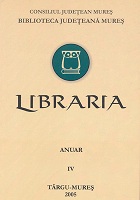Tipografia românească de la Buda în timpul cenzoratului lui Petru Maior. 1809 - 1821
The Romanian Typography of Buda During Petru Maior’ s Activity as a Censor. 1809 - 1821
Author(s): Monica AvramSubject(s): Library and Information Science, Library operations and management, 19th Century
Published by: Biblioteca Județeană Mureș
Keywords: Romanian Typography; Buda; Petru Maior; Censor;
Summary/Abstract: It is today accepted the fact that the 18th century has influenced the European society more profoundly than any other historical age. According to the ideas promoted by the new cultural current, the need for written texts was more and more obvious and the authorities tried to respond to this necessity by encouraging the activity of different printing houses or by laying the foundations of new ones. Thus, during Maria Tereza’ s reign, was founded the typography from Buda, in 1777, by moving in the Hungarian capital the typographic materials from the University of Tîrnavia. Its instruments were improved during time in different ways: buying the already known letters used by Ştefan Novacovici at Vienna, în 1795; making its own materials, by engaging letter makers etc. The rules of functioning were established in 1779; according to them, the new typography’ s role was to assure the necessary writings for a better national learning. In order to guarantee the best quality of the writings that were about to be published, an educated and honest man was going to check every material send for publication. Among those who spent a part of their life and career at Buda, as censors, we may mention Samuil Micu, Gheorghe Şincai and others; but it is certain that the most important one was Petru Maior, who was in charge between 1809 - 1821. His activity at Buda is characterized by two main aspects: quality and diversity. His aim was to raise the scientific level of the materials printed at Buda and succeeded in doing this by selecting carefully the written texts he received. Maior published at Buda, as author, 13 volumes in 11 years and he successfully managed to translate into Romanian some of the most appreciated texts at that moment. In this way, he tried to assure Romanian scholars’ s access to European and universal cultural values. During his activity as censor, at Buda were published 102 books, divided into diferent domains; among them, 92 books were written in Romanian, representing (90,19%). The results of typographic activity of Buda are relevant for Romanian cultural and social development. The books printed at Buda, that became one of the most important European cultural centers, made the connections between the Romanians all over the Danubian space and also contributed to the evolution and spreading of enlightenment ideals.
Journal: Libraria. Studii și cercetări de bibliologie
- Issue Year: IV/2005
- Issue No: 4
- Page Range: 227-242
- Page Count: 16
- Language: Romanian

